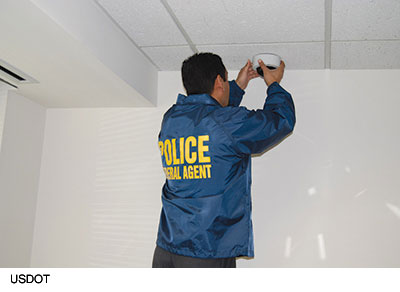
DEPARTMENTS | |
| Public Roads Home | |
January/February 2008 · Vol. 71 · No. 4
January/February 2008
Is Your Construction Project a Victim of Crime?
by Jim H. Crumpacker
"Red flag" indicators offer insights to help contracting officers, project managers, and others detect fraud schemes.
 |
| (Above) OIG special agents occasionally use concealed recording devices during investigations involving allegations of fraud and corruption. |
The consequences of fraud within the transportation community can be staggering—with millions of dollars potentially siphoned off from agency budgets each year. Such fraud also can result in opportunity costs, loss of public trust in transportation officials and programs, project delays, increased costs, deployment of inferior transportation products or systems, funding shortfalls, and unmet program goals. All of these results adversely affect the entire transportation network. In recent years, the U.S. Department of Transportation's (USDOT) Office of Inspector General (OIG) has noted that transportation officials and project managers are devoting more attention to mechanisms that detect and prevent fraud. (See the companion article "Upholding the Public Trust")
Special agents in OIG are responsible for investigating fraud schemes that involve Federal funds and programs. Brief descriptions of these schemes, along with sample "red flag" indicators for each scheme, are offered here as a tool for transportation professionals to help them detect fraud when doing business on behalf of the American public. It is important to note that the presence of one or more indicators does not necessarily prove fraud, nor are the indicators shown all-inclusive for each of the schemes described.
Bid Rigging and Collusion
In bid rigging and collusion, contractors misrepresent that they are competing against each other when, in fact, they agree to cooperate on the winning bid to increase job profit. Watch for:
- Unusual bid patterns: too close, too high, round numbers, or identical winning margins or percentages
- Different contractors making identical errors in contract bids
- Bid prices dropping when a new bidder enters the competition
- Rotation of winning bidders by job, type of work, or geographical area
- Losing bidders hired as subcontractors
- Apparent connections between bidders: common addresses, personnel, or telephone numbers
- Losing bidders submitting identical line item bid amounts on nonstandard items
Materials Overcharging
Under this fraud scheme, a contractor misrepresents how much construction material was used on the job and then is paid for excess material to increase job profit. Watch for:
- Discrepancies between contractor- provided quantity documentation and observed data, including yield calculations
- Refusal or inability to provide supporting documentation
- Contractor consistently loading job materials into equipment away from inspector oversight
- Truck weight tickets or plant production records with altered or missing information
- Photocopies of quantity documentation where originals are expected
- Irregularities in color or content of weight slips or other contractor documents used to calculate pay quantities
Time Overcharging
In a time overcharging scheme, a consultant or contractor misrepresents the distribution of employee labor on jobs in order to charge for more work hours, or a higher overhead rate, to increase profit. Watch for:
- Unauthorized alterations to time—cards and other source records
- Billed hours and dollars consistently at or near budgeted amounts
- Timecards filled out by supervisors, not by employees
- Photocopies of timecards where originals are expected
- Inconsistencies between consultant's labor distribution records and employee timecards
Product Substitution
In a scheme involving product substitution, a contractor misrepresents the product used in order to reduce costs for construction materials. Watch for:
- Any mismarking or mislabeling of products and materials
- Contractor restricting or avoiding inspection of goods or services upon delivery
- Contractor refusing to provide supporting documentation regarding production or manufacturing
- Photocopies of necessary certification, delivery, and production records where originals are expected
- Irregularities in signatures, dates, or quantities on delivery documents
- High rate of rejections, returns, or failures
- Test record reflecting no failures or a high failure rate but contract is on time and profitable
- Unsigned certifications
 |
| Unauthorized alterations to timecards like those shown here is a type of fraud in which a contractor misrepresents employee labor, for example, by charging for more work hours in order to increase profit. |
Disadvantaged Business Enterprises (DBE) Business Fraud
Under this fraud scheme, a contractor misrepresents who performed the contract work in order to increase job profit while appearing to be in compliance with contract goals for involvement of minority- or women-owned businesses. Watch for:
- Minority owner lacking background, expertise, or equipment to perform subcontract work
- Employees shuttling back and forth between prime contractor and minority-owned business payrolls
- Business names on equipment and vehicles covered with paint or magnetic signs
- Orders and payment for necessary supplies made by individuals not employed by minority-owned business
- Prime contractor facilitated purchase of minority-owned business
- Minority-owned business owner never present at job site
- Prime contractor always uses the same minority-owned business
Quality-Control Testing Fraud
In this scheme, a contractor misrepresents the results of quality control (QC) tests to earn contract incentives falsely or to avoid production shutdown in order to increase profits or limit costs. Watch for:
- Contractor employees regularly taking or labeling QC samples away from inspector oversight
- Contractor insisting on transporting QC samples from the construction site to the lab
- Contractor not maintaining QC samples for later quality assurance (QA) testing
- Contractor challenging results or attempting to intimidate QA inspectors who obtain conflicting results
- Photocopies of QC test results where originals are expected
- Alterations or missing signatures on QC test results
Bribery
Bribery occurs when a contractor misrepresents the cost of performing work by compensating a government official for permitting contract overcharges to increase contractor profit. Watch for:
- Other government inspectors at the job site noticing a pattern of preferential contractor treatment
- Government official having a lifestyle exceeding his or her salary
- Contract change orders lacking sufficient justification
- Oversight officials socializing with, or having business relationships with, contractors or their families
Kickbacks
In kickback schemes, a contractor or subcontractor misrepresents the cost of performing work by secretly paying a fee for being awarded the contract and therefore inflating the job cost to the government. Watch for:
- Unexplained or unreasonable limitations on the number of potential subcontractors contracted for bid or offer
- Continuing awards to subcontractors with poor performance records
- Nonaward of subcontract to lowest bidder
- "No-value-added" technical specifications that dictate contract awards to particular companies
Conflicts of Interest
In fraud involving conflict of interest, a contracting or oversight official misrepresents that he or she is impartial in business decisions when he or she has an undisclosed financial interest in a contractor or consultant who inflates the job cost to the government. Watch for:
- Unexplained or unusual favoritism shown to a particular contractor or consultant
- Government official disclosing confidential bid information to a contractor or assisting the contractor in preparing the bid
- Employee having discussions about employment with a current or prospective contractor or consultant
- Close socialization with and acceptance of inappropriate gifts, travel, or entertainment from a contractor
- Vendor or consultant address being incomplete or matching employee's address
- Government official leasing or renting equipment to a contractor for performing contract work
False Statements and Claims
False statements or claims made "knowingly and willfully" constitute fraud. Knowledge is defined as (1) actual knowledge of falsity, (2) deliberate ignorance of truth or falsity, or (3) reckless disregard of truth or falsity. Watch for:
- Discrepancies between reported facts and observed data and supporting documentation
- Discrepancies between reported facts and test and inspection results
- Refusal or inability to provide supporting documentation
- Inadequate or apparently altered supporting documentation
- Repeated "errors" that benefit the contractor
- Unreasonable claims or statements compared to prior performance or industry standards
- High rate of rejections, returns, or failures
- Site inspection reports indicating less progress than reported
- Complaints from users
 |
| As part of a surveillance operation, an OIG special agent installs an overt camera to help substantiate allegations received via the OIG Hotline. Agents sometimes also use covertly installed cameras to obtain evidence of crimes. |
Reporting Concerns About Fraud, Waste, Abuse, or Mismanagement
OIG maintains a hotline (see "Methods for Reporting Fraud" above) to report allegations of fraud, waste, abuse, or mismanagement in USDOT programs or operations. Allegations may be reported by USDOT employees, contractors, or the public. The OIG Hotline is available 24 hours a day, 7 days a week. Issues that should be reported include the following:
- Contract, procurement, and grant fraud
- Environment, health, and safety violations
- Computer crimes
- Product substitution and suspect/counterfeit parts
- Bribery, kickbacks, and gratuities
- False statements and false claims
- Conflicts of interest and ethics violations
- Travel fraud, theft, and/or abuse of government property
- Other violations of Federal laws and regulations
Methods for Reporting FraudReport suspicions and allegations of fraud, waste, abuse, or mismanagement to OIG by using one of the following methods:
Note: The OIG Hotline is obligated to expeditiously forward all safety-related complaints to USDOT's safety regulatory agencies for action, as appropriate. |
A Final Word
Not all businesses are on a mission to defraud Federal, State, or local governments or the American people. In fact, most businesses are composed of responsible and conscientious professionals who want to do a good job and provide superior products and services. However, the Latin warning caveat emptor , which means "Let the buyer beware," applies.
Agency transportation professionals at all levels of government are responsible and accountable for the stewardship and oversight of taxpayer money entrusted to them. Proactively recognizing the signs of potential fraud at each stage of a construction project and taking action, as appropriate, will go a long way in helping to detect and stop fraud.
American taxpayers rely on professionals like us—project managers, contracting professionals, engineers, inspectors, auditors, and compliance officers--to serve as their eyes and ears, and the success of the transportation system and the trust of the American people rely on our success. In the words of Abraham Lincoln, the 16th President of the United States, "If once you forfeit the confidence of your fellow citizens, you can never regain their respect and esteem."
Jim H. Crumpacker has served with the USDOT OIG since 2003. Previously he worked for the U.S. Postal Service OIG and the U.S. Air Force Audit Agency. He also is a colonel in the U.S. Air Force Reserve and a federally credentialed special agent with the U.S. Air Force Office of Special Investigations (AFOSI), whose mission is to identify, investigate, and neutralize criminal, terrorist, and espionage threats to Air Force and U.S. Department of Defense personnel and resources. In this capacity, he currently serves as the individual mobilization augmentee to AFOSI's executive director at Andrews Air Force Base, MD.
For more information, see www.oig.dot.gov or contact Jim H. Crumpacker at 202-366-1420 or jim.crumpacker@oig.dot.gov.
Other Articles in this issue:
Is Your Construction Project a Victim of Crime?
QuickZone: Modeling In the Zone
The Corporate Master Plan Shapes R&T Practice
January/February 2008 · Vol. 71 · No. 4